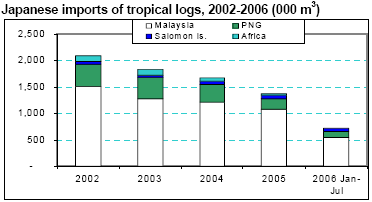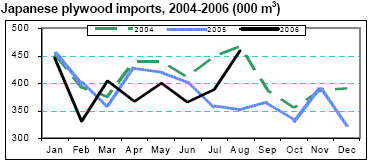Japan Wood Products
Prices
Dollar Exchange Rates of 30th
Oct. 2006
Japan Yen 117.47
Reports From Japan
Japan log intake snapped declining import trend
Import of tropical logs by Japan surged 27% to 130,938 m3 in July. However, total Japanese
imports of tropical logs amounted to 721,377 m3 in the year to July, 16% below last
year’s import volume (see chart). Japan’s total supply of Southeast logs fell 16.5%
to 742,900 m3 up to
July while inventories declined 17.3% to 278,800 m3, equivalent to 2.7 month supply.
Accumulated log imports in 2006 have come from Malaysia (75%, two-thirds of which from
Sarawak), PNG (15%), Salomon Isl (9%) and Africa (1%).

July-arrivals of Southeast Asian logs in Japan had not been cleared through the customs
by mid-October due to delays in weighing operations in Tokyo Port. The office was short of
workers. In Sarawak, logging operations were facilitated by increased river volume due to
rains in
September. In contrast, logging operations were affected by the rains in Sabah.
Log prices stay firm amid some market resistance
Log prices in Japan continued to firm due to high FOB prices and a weakening yen.
However, plywood manufacturers were resisting higher log prices because price increases of
tropical plywood were slowing down and imports of these products were recovering, reducing
speculative movements in the market.
China becomes Japan’s second largest lumber supplier
Japan’s imports of Southeast lumber amounted to 46,600 m3 in August (see chart).
Accumulate lumber imports through August fell 4.6% to 347,400 m3, compared with the same
period last year. Imports from Malaysia surged 4.7% to 132,950 m3 while those from
Indonesia plunged
29% to 87,100 m3. Imports from China rose 8.3% to 107,500 m3, surpassing those from
Indonesia and making China the second largest lumber supplier to Japan.

Japan enforces legal documents on timber imports
The presentation of “legality documents”, proving that the origin of timber for
lumber and construction material used in public construction work is legal, came into
effect on 1 October in Japan. Export permits from PNG and Malaysia (Sabah and Sarawak),
Japan’s main log and lumber suppliers, would be recognized in Japan as documents
proving timber legality, according to the Tokyo Chapter of the Japan Southeast Lumber
Conference. Japan was also studying legality requirement for Brazilian timber products
such as ipe for exterior use.
Concerning imports from China, which have rapidly grown in recent years, some said that
proving legality of timber products was rather difficult. This was due to the fact that
Russian oak, ash and other species were used for flooring, plywood and lumber products and
tracing the
origin of the logs used by each Chinese manufacturer would be very complicated.
Increased imports drive plywood supply up in Japan
Total volume of plywood supply rose to 714,000 m3 in August, up 5.5% from July, helped by
a rise in plywood imports. Domestic plywood supply fell 11.7% to 255,213 m3 while imports
rose 18.2% to 459,496 m3. By import source, 220,000 m3 came from Malaysia (up 4.1%) and
167,000 m3 from Indonesia, which exceeded the 160,000 m3 level for the first time in over
a year. Plywood imports recovered in August due to greater diversion of logs for plywood
production in Southeast Asia lured by attractive prices in Japan. However, plywood supply
from Southeast Asia was expected to decline in September-October due to Ramadan and
associated festivities.
In spite of the larger supply, Japanese prices for structural, concrete forming and thick
plywood remained bullish due to a sizeable backlog of unfilled orders. Prices for medium
and thin panels were stabilizing as inquiries were getting back to normal.

New housing starts regain upward trend
Total housing starts resumed their upward trend, rebounding 4.3% to 106,649 units in
August, up 1.8% from a year ago (see chart). The growth was supported by gains in
built-for-sale and owner-occupied houses.
Wood-based units accounted for 45% of the total housing starts, down from 46% last month.
However, wood structured houses increased for the eleventh consecutive month compared with
one year earlier. Seasonally adjusted annual starts reached 1.296 million units, the
fourth consecutive month over the 1.2 million level. In Jan-Aug 2006, total housing starts
were 4.1% above the pace in 2005.

FA releases forecast of timber supply and demand
Japan’s Forestry Agency (FA) released its forecast of timber supply and demand for
the second half of 2006 and first quarter of 2007. According to the FA, the recovery of
new housing starts in the second half of 2006 would drive demand for wood products and
building materials up. However, imports of tropical logs and lumber from Southeast Asia
are projected to decline due to continuing shortages in major production regions. Plywood
imports in 2006 are expected to exceed those in 2005, but will still be lower than in
2004.

“Eco-value Wood” to compete with tropical boards
Sekisui Chemical’s Environment and Life Company will start making new wood materials
with waste wood and thinning. The ‘Eco-value Wood’ involves basically the same
manufacturing method as wood chip based board. The production technique allows arranging
variable shaped wood chips into one direction and heating time can be ten times faster
than normal press. By changing pressure, strength and hardness can be adjusted for the use
of the material. The maximum board size would be 150 mm thick, 720 mm wide and 4,300 mm
long.
The hardest and strongest board materials can be used for truck flooring, flooring and
interior decorative wall. According to Sekisui, the material is about 1.5 times as hard
and as strong as keruing, the hardest Southeast Asian
species used for truck floor. The board is expected to compete with Southeast Asian board
products at a target price of 150,000 yen per m3 (around $1,270 per m3). Sekisui will
construct a plant in Ohta, Gunma prefecture, with a total investment of one billion yen.
It expects to have a monthly production of about 1,500 m3 and reach sales of about five
billion yen a year by 2010.

|